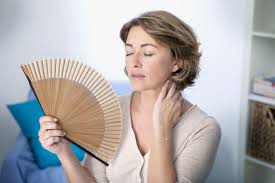Aileen blew into my office like a Summer storm. “Help me, I’m a poster child for Hormones from Hell!” After catching my breath, I assured her that there were many ways of dealing with the ravages of hot flashes, dry skin, mood changes and forgetfulness. I started by reinforcing that menopause is not a disease. Inaccurately and unfortunately there is a pervasive sense that menopause is the “ultimate and inevitable bad experience” for aging women. I jokingly explained that women were not designed to self-destruct at fifty!
Menopause is a normal, natural transition, and it is vital for women to view it with a positive perspective. That simple understanding is the cornerstone
in building a plan to thwart the symptoms of “the change.” But it is equally important to realize that not everyone has a problem with menopause.
As a physician, my experience treating menopausal women is that there are some universal similarities in women’s experiences, but because of every person’s unique physiology and life journey, this time in a woman’s life is very individualized.
I am a “recovering traditionalist”. I was trained in the old school approach to menopause (which means drugs, and if that didn’t work, more drugs). In almost twenty years of practice I have found that many women are not satisfied with their options and many discover that their “treatments” are worse than their symptoms. Especially in this age of “estrogen panic” where the media (and many physicians) has touted misleading and confusing advice on hormones, many women are looking towards alternative treatments for their symptoms. One woman put it well. She said, “Physicians have a duty to give a woman the best care they can provide, especially their options. However each person is ultimately responsible for his or her own health. We, the patients, need help, guidance, and a listening ear.” Those were powerful and challenging words.
The general dissatisfaction among women is amplified by the observation that only 17% of eligible women in the US are taking some type of hormone replacement and up to 80% of women who start on hormones stop them after two years! The needs of women are not being met! This problem with compliance is due to poor communication and fear. After all, treatment of symptoms is not limited to simply taking a drug. Successfully navigating the potentially turbulent waters of menopause requires a more comprehensive approach.
Herbs, complimentary teachings, diet, and exercise all should be discussed along with hormones. The main caveat surrounding these modalities is that they must be held to the same standard and scrutiny that safeguards traditional hormone replacement.
The major problem in meshing the traditional and complimentary approaches to health is a mistaken perception of mutual exclusivity. These treatments can coexist and be complimentary.
I am saying that choice and personal responsibility are keys to unlock a joyous menopause.
This is an opportunity to live with passion and fulfill your life mission. This is a time to take stock of the past and choose your path for the future. The choice is yours. It is a choice that is difficult if not impossible to make wisely without sound information and guidance.
THE 4 “A”s
Many of the lifestyle choices you make, such as diet and exercise, can dramatically affect your menopausal experience. It is not a time to be complacent or anxious. It is a time- a season- to rejoice and celebrate the joy of living.
Following the four “A”s, Attitude, Action, Aptitude and Apothecary, can be the prescription for menopausal merriment. Attitude- what we believe is our reality, what we know is our truth. Belief plays a major role in the symptoms of menopause. Our thoughts become our actions, our actions become our deeds, our deeds become our habits, our habits become our character, and our character becomes our legacy. In many instances, if you anticipate a horrible experience, you will be right!
Action- this involves two levels. First, acting on your knowing. The key to any successful person, whether it’s in business, raising a family, or celebrating menopause is taking action. There is nothing more sad than a good idea that dies from loneliness or lack of attention. Whether that’s using hormones, herbs, massage therapy or exercise, you have to take action to achieve results.
The second part of action is exercise. It is the fountain of youth and can help in reducing both weight and hot flashes!
Aptitude- educate yourself, learn your options. Ask questions, talk to others, and take responsibility. Through knowledge about menopause, you eliminate fear and create opportunities. M.D. does not mean menopause director! Learn so you can be a partner in your health care.
Apothecary- We have a plethora of medicines and natural substances to treat the symptoms of menopause. These are merely tools; however, they cannot stand alone.
Explore your options and live joyously and healthy.












